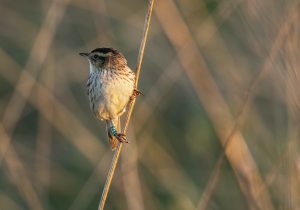
After the first count of rare birds – Aquatic Warblers – in the Žuvintas Biosphere Reserve, Lithuania, naturalists are extremely happy – 27 singing males were found and this is the largest population of these songbirds ever found in this area. Compared to last year, the population has almost doubled. According to naturalists, such a sudden increase in the number of birds can be related to the successful translocation of Aquatic warbler from Belarus to Lithuania and the improving conditions of habitats in Žuvintas.
“During the counting, wandering around the Žuvintas wetlands and listening to the Aquatic Warblers I had a very good feeling and a strong perception that we are on the right track in protecting this bird. There was an excitement too, similar to the one that flood you before the concert of your favourite band, which you have been waiting for many years and you are finally standing in front of a stage hoping for the first chords of your favourite song. From a conservation point of view, the result far exceeds initial expectations. It is undoubtedly linked to many years of consistent work on habitat restoration and, for the first time in the world, the successful translocation program for these long-distance migrants. When planning the translocation experiment, we set ourselves the goal of successfully raising the chicks and expected at least one them to return after the winter migration. Now we are delighted to see signs of a viable population recovery, and this gives us hope that the rarest European songbird, who is on the edge of extinction, will be preserved.” – says Žymantas Morkvėnas, the director of the Baltic Environmental Forum Lithuania and a manager of Aquatic Warbler conservation project in Lithuania and Belarus.
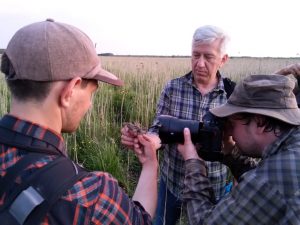
Arūnas Pranaitis, the director of the Žuvintas Biosphere Reserve, adds to his colleague: “I was very pleased with this kind of recovery. This is the result of many years of efforts to revive probably the largest surviving wetland massif in Lithuania and the globally endangered species living here. When, a long time ago, after long years of uncertainty in 1986, we found an Aquatic Warbler in Žuvintas sedges, there could be up to 30 singing males. Then every year everything went worse and worse: the swamp was disappearing, overgrown with willows, black alders and reeds, until the Aquatic Warblers had almost no place to live. At the beginning of environmental management work since 2007, only 1-3 birds sang there. The current number is really gratifying, but maybe is not even a limit, because there are still a lot of wetlands that are being restored to a better condition.”

Increase of population is associated with success of translocation from Belarus
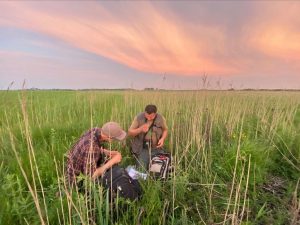
For almost a decade, the population of Žuvintas Aquatic Warblers has been on the verge of extinction – 1-8 singing males have been counted. The efforts to protect these rare birds by restoring habitats did not have a significant impact on the population – it was so degraded that it was naturally unable to recover suddenly. There was a risk that in the event of a major drought or other disaster, this population could disappear completely, as did similar populations in Hungary and Germany. After long discussions with scientists, detailed planning for 2018-2019 naturalists performed the translocation of Aquatic Warblers. In two years, 100 juveniles of these birds were brought to the endangered population of Žuvintas from the largest habitat of these birds in Belarus. As many as 99 of them were successfully grown and released into the fenmire by naturalists. Already after the first year of translocation, naturalists were happy about the success of this method. In spring of 2019, 11 birds (22%) returned from wintering in Africa to Žuvintas were observed. This indicator exceeded even the natural return rate of first year birds (20%). This year, 5 translocated birds from the last year were observed as returned to Žuvintas after wintering. 2 of those birds were females and 3 of them were males. Also 3 males that were brought here two years ago were observed.
 “Two years ago, we decided to be the first ones in the world to try a conservation measure that has not been applied with this species before – a translocation. Now we are clearly seeing the success and excellent results of the method. Although the final number of returned translocated birds this year will only be summarised at the end of the summer, this year we have already observed the birds returning to Žuvintas from both years of translocation. The fact that birds (even three of them), translocated in 2018 returned here for the second year in a row, show that the crucial moment of translocation – memorising a new home and attachment to this area (imprinting) – was a great success. The bond of Aquatic Warblers with Žuvintas wetlands is very strong. Since Aquatic Warblers usually live for 3-4 years, having the third-year-old birds came back also means that they grew up strong, healthy and the conditions here are good,” said Ž. Morkvėnas.
“Two years ago, we decided to be the first ones in the world to try a conservation measure that has not been applied with this species before – a translocation. Now we are clearly seeing the success and excellent results of the method. Although the final number of returned translocated birds this year will only be summarised at the end of the summer, this year we have already observed the birds returning to Žuvintas from both years of translocation. The fact that birds (even three of them), translocated in 2018 returned here for the second year in a row, show that the crucial moment of translocation – memorising a new home and attachment to this area (imprinting) – was a great success. The bond of Aquatic Warblers with Žuvintas wetlands is very strong. Since Aquatic Warblers usually live for 3-4 years, having the third-year-old birds came back also means that they grew up strong, healthy and the conditions here are good,” said Ž. Morkvėnas.
“On the European continent, the situation with Aquatic Warblers is unfortunately not as gratifying as our experience in Žuvintas. In this year we faced a very dry Spring and a lot of birds habitats were destroyed by fires. The fire engulfed about 6000 ha of the Biebrza wetland, the most important habitat for Aquatic Warbler in Poland. In Belarus, fires have destroyed about 3000 ha of this rare bird’s habitats. In Ukraine, the exact area destroyed by the fire is unknown, but ornithologists report mass fires. It is possible that part of Aquatic Warblers flew to Žuvintas after abandoning the habitats destroyed by fires. This will become clearer after longer researches of the species in the coming years. If the research confirms that the birds actually came from neighbouring countries, it will also be a very good and encouraging message – it means that birds can fly quite long distances in search of suitable habitats,” explained Ž. Morkvėnas.
Special rings help to distinguish the birds
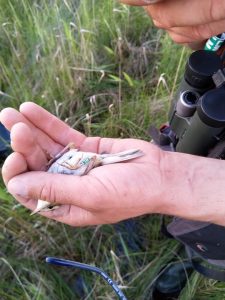
Almost every other day, A. Pranaitis, who is now going to register and observe new singing Aquatic warblers in Žuvintas, explains how he distinguishes the observed birds: “Most of the Aquatic warblers are ringed, the ones that were translocated, raised and released to Žuvintas from Belarus are marked with green rings with numbers and letters; meanwhile, other, wild-grown Aquatic warblers are marked with unique combinations of tiny coloured rings that allow each bird to be identified through a telescope. Well, and the non-ringed birds are last year’s chicks, or birds that have come from other areas. Constantly watching these birds, we see how Aquatic warblers are increasing this summer, although the beginning of the summer was neither pleasant nor promising for these birds.”
Aquatic warbler population size in Žuvintas can still increase
The estimated size of the Aquatic Warbler population in June in the Žuvintas Biosphere Reserve is not final yet. It may still increase after the second counting in early July. Methodologically, the size of the Aquatic Warbler population in Žuvintas and other habitats is determined by singing males, performing it twice – in early June and early July. After the second count, the results of both counts are compared and final maximum number of males is determined.
Currently, the generalised data of the first counts from other Aquatic Warbler habitats in Lithuania also is being finalised.


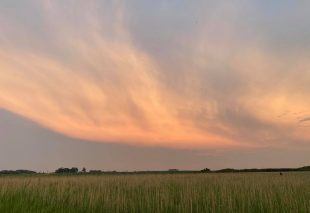
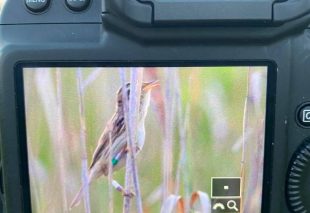
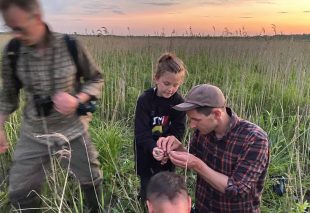

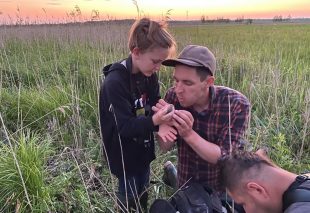







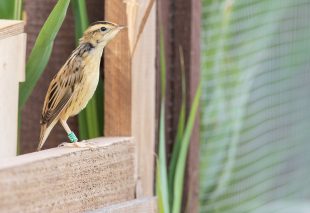
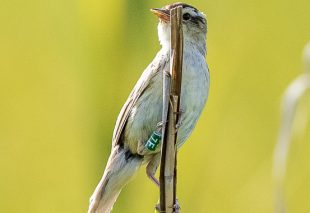





Reviews